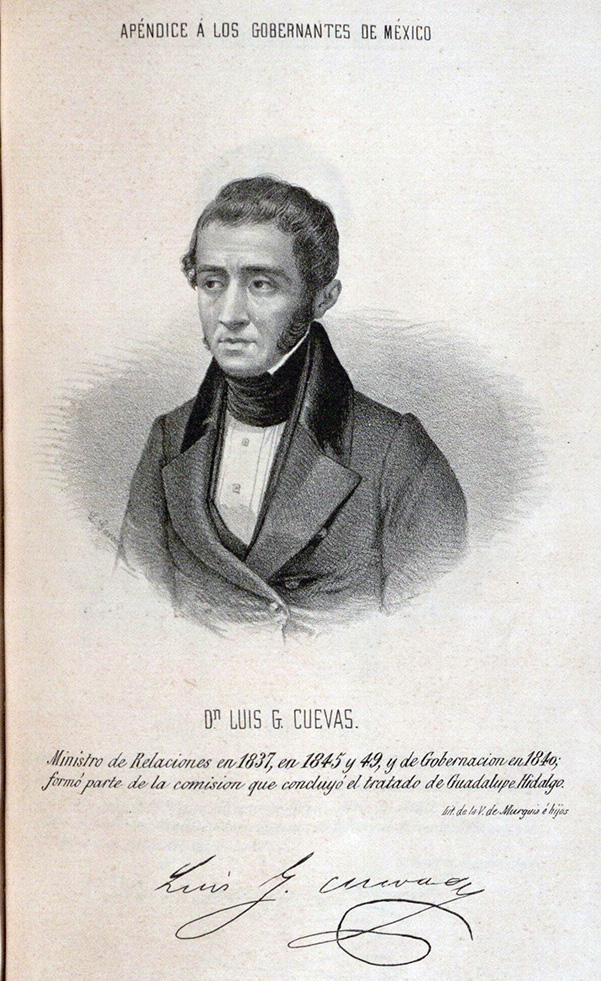Luis Gonzaga Cuevas
July 10, 1799 - January 12, 1867
Luis Gonzaga Cuevas, a conservative Mexican government official and diplomat, participated in the negotiating and writing of the Treaty of Guadalupe-Hidalgo in 1848. Born to a wealthy family in Lerma, State of Mexico in 1799, Cuevas earned a law degree from the Colegio de San Ildefonso in Mexico City. By 1835 he entered government service and assumed various diplomatic posts.
Cuevas briefly became minister of foreign affairs in 1836. While in France on a diplomatic mission, he met the exiled former president Anastasio Bustamante. The following year, Bustamante returned to Mexico and reassumed the presidency. He appointed Cuevas minister plenipotentiary of France during the Pastry War (1838-1839).
Critical of U.S. and Texan expansionism, Cuevas asserted that Mexico's southern neighbors and other Spanish-controlled territories should come to Mexico's defense in the event that the U.S. should try to annex Texas or acquire other Mexican lands. In 1845, prior to the U.S. annexation of Texas, British and French diplomats attempted to facilitate a peace between Mexico and Texas. Cuevas presented their proposal to the Mexican Congress, which recognized the Republic of Texas that April. The Texas Congress, however, rejected the peace proposal and voted for annexation.
After the U.S.-Mexico War began in May 1846. Along with other government officials, Cuevas fled Mexico City just prior to U.S. General Winfield Scott's assault on the city in September 1847. As U.S. victories accumulated, Mexico found itself forced to negotiate a peace. Unlike some federalists and liberals who wished to continue the war, Cuevas supported an immediate peace, despite Mexico's weakened position.
Nicholas P. Trist, a U.S. diplomat initially sent to negotiate a peace prior to the fall of Mexico City, made contact with the central government and moved to reopen peace talks. Cuevas, along with Bernardo Couto and Miguel Atristain, was appointed as a peace commissioner. Secretly meeting in the town of Guadalupe Hidalgo, Cuevas, Trist, and the other Mexican commissioners spent most of January 1848 negotiating an end to the war. On February 2, 1848, Trist and the Mexican commissioners signed the Treaty of Guadalupe Hidalgo. The treaty established the Rio Grande as the southern border, and granted the U.S. Upper California and New Mexico in exchange for $15 million and the U.S. assumption of liability over $3 million in unpaid claims made by U.S. citizens against the Mexican government. Cuevas defended the treaty, which he helped write, to the Mexican Congress. He subsequently participated in a meeting with U.S. commissioners to reconcile modifications made to the treaty by the U.S. Senate.
After the war, Cuevas intermittently served as foreign secretary. In 1851 his conservative critique of Mexican history, Porvenir de México, was published. The book praised religion as a foundation of stability and progress, and celebrated the short-lived rule of Emperor Augustín de Iturbide.
During the French invasion of Mexico in the early 1860s, the French-installed Emperor Maximilian I wanted Cuevas to participate in the imperial government. Cuevas refused to collaborate. In 1867, he died in Mexico City.
Bibliography
Crawford, Mark, David S. Heidler, and Jeanne T. Heidler. Encyclopedia of the Mexican-American War. Santa Barbara: ABC-CLIO, 1999.
Griswold del Castillo, Richard. The Treaty of Guadalupe Hidalgo: A Legacy of Conflict. Norman: University of Oklahoma Press, 1990.
Nance, Joseph Milton. "Republic of Texas." Handbook of Texas Online. http://www.tshaonline.org/handbook/online/articles/mzr02. Accessed June 28, 2015. Uploaded on June 15, 2010. Published by the Texas State Historical Association.
Tucker, Spencer C. The Encyclopedia of the Mexican-American War: A Political, Social, and Military History. Santa Barbara: ABC-CLIO, 2012.

